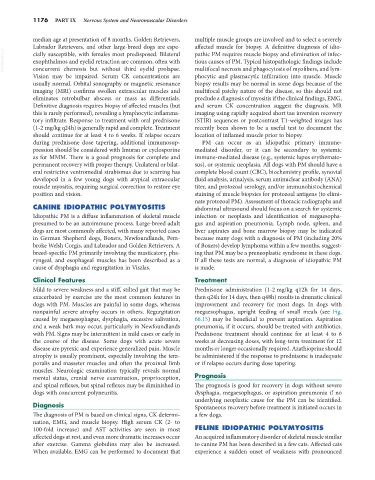Page 1204 - Small Animal Internal Medicine, 6th Edition
P. 1204
1176 PART IX Nervous System and Neuromuscular Disorders
median age at presentation of 8 months. Golden Retrievers, multiple muscle groups are involved and to select a severely
Labrador Retrievers, and other large-breed dogs are espe- affected muscle for biopsy. A definitive diagnosis of idio-
VetBooks.ir cially susceptible, with females most predisposed. Bilateral pathic PM requires muscle biopsy and elimination of infec-
tious causes of PM. Typical histopathologic findings include
exophthalmos and eyelid retraction are common, often with
concurrent chemosis but without third eyelid prolapse.
phocytic and plasmacytic infiltration into muscle. Muscle
Vision may be impaired. Serum CK concentrations are multifocal necrosis and phagocytosis of myofibers, and lym-
usually normal. Orbital sonography or magnetic resonance biopsy results may be normal in some dogs because of the
imaging (MRI) confirms swollen extraocular muscles and multifocal patchy nature of the disease, so this should not
eliminates retrobulbar abscess or mass as differentials. preclude a diagnosis of myositis if the clinical findings, EMG,
Definitive diagnosis requires biopsy of affected muscles (but and serum CK concentration suggest the diagnosis. MR
this is rarely performed), revealing a lymphocytic inflamma- imaging using rapidly acquired short tau inversion recovery
tory infiltrate. Response to treatment with oral prednisone (STIR) sequences or postcontrast T1-weighted images has
(1-2 mg/kg q24h) is generally rapid and complete. Treatment recently been shown to be a useful test to document the
should continue for at least 4 to 6 weeks. If relapse occurs location of inflamed muscle prior to biopsy.
during prednisone dose tapering, additional immunosup- PM can occur as an idiopathic primary immune-
pression should be considered with Imuran or cyclosporine mediated disorder, or it can be secondary to systemic
as for MMM. There is a good prognosis for complete and immune-mediated disease (e.g., systemic lupus erythemato-
permanent recovery with proper therapy. Unilateral or bilat- sus), or systemic neoplasia. All dogs with PM should have a
eral restrictive ventromedial strabismus due to scarring has complete blood count (CBC), biochemistry profile, synovial
developed in a few young dogs with atypical extraocular fluid analysis, urinalysis, serum antinuclear antibody (ANA)
muscle myositis, requiring surgical correction to restore eye titer, and protozoal serology, and/or immunohistochemical
position and vision. staining of muscle biopsies for protozoal antigens (to elimi-
nate protozoal PM). Assessment of thoracic radiographs and
CANINE IDIOPATHIC POLYMYOSITIS abdominal ultrasound should focus on a search for systemic
Idiopathic PM is a diffuse inflammation of skeletal muscle infection or neoplasia and identification of megaesopha-
presumed to be an autoimmune process. Large-breed adult gus and aspiration pneumonia. Lymph node, spleen, and
dogs are most commonly affected, with many reported cases liver aspirates and bone marrow biopsy may be indicated
in German Shepherd dogs, Boxers, Newfoundlands, Pem- because many dogs with a diagnosis of PM (including 20%
broke Welsh Corgis, and Labrador and Golden Retrievers. A of Boxers) develop lymphoma within a few months, suggest-
breed-specific PM primarily involving the masticatory, pha- ing that PM may be a preneoplastic syndrome in these dogs.
ryngeal, and esophageal muscles has been described as a If all these tests are normal, a diagnosis of idiopathic PM
cause of dysphagia and regurgitation in Viszlas. is made.
Clinical Features Treatment
Mild to severe weakness and a stiff, stilted gait that may be Prednisone administration (1-2 mg/kg q12h for 14 days,
exacerbated by exercise are the most common features in then q24h for 14 days, then q48h) results in dramatic clinical
dogs with PM. Muscles are painful in some dogs, whereas improvement and recovery for most dogs. In dogs with
nonpainful severe atrophy occurs in others. Regurgitation megaesophagus, upright feeding of small meals (see Fig.
caused by megaesophagus, dysphagia, excessive salivation, 66.15) may be beneficial to prevent aspiration. Aspiration
and a weak bark may occur, particularly in Newfoundlands pneumonia, if it occurs, should be treated with antibiotics.
with PM. Signs may be intermittent in mild cases or early in Prednisone treatment should continue for at least 4 to 6
the course of the disease. Some dogs with acute severe weeks at decreasing doses, with long-term treatment for 12
disease are pyrexic and experience generalized pain. Muscle months or longer occasionally required. Azathioprine should
atrophy is usually prominent, especially involving the tem- be administered if the response to prednisone is inadequate
poralis and masseter muscles and often the proximal limb or if relapse occurs during dose tapering.
muscles. Neurologic examination typically reveals normal
mental status, cranial nerve examination, proprioception, Prognosis
and spinal reflexes, but spinal reflexes may be diminished in The prognosis is good for recovery in dogs without severe
dogs with concurrent polyneuritis. dysphagia, megaesophagus, or aspiration pneumonia if no
underlying neoplastic cause for the PM can be identified.
Diagnosis Spontaneous recovery before treatment is initiated occurs in
The diagnosis of PM is based on clinical signs, CK determi- a few dogs.
nation, EMG, and muscle biopsy. High serum CK (2- to
100-fold increase) and AST activities are seen in most FELINE IDIOPATHIC POLYMYOSITIS
affected dogs at rest, and even more dramatic increases occur An acquired inflammatory disorder of skeletal muscle similar
after exercise. Gamma globulins may also be increased. to canine PM has been described in a few cats. Affected cats
When available, EMG can be performed to document that experience a sudden onset of weakness with pronounced

